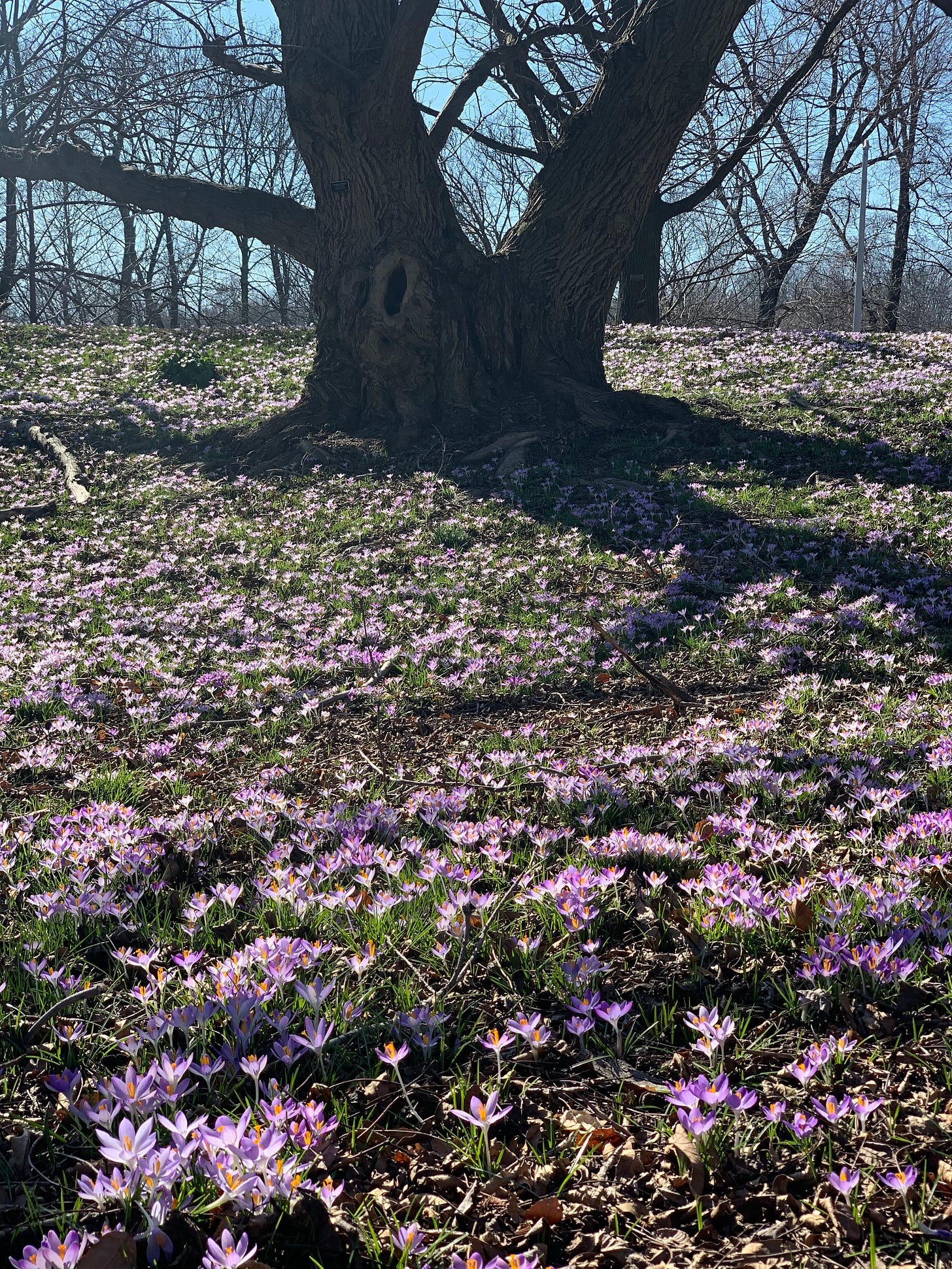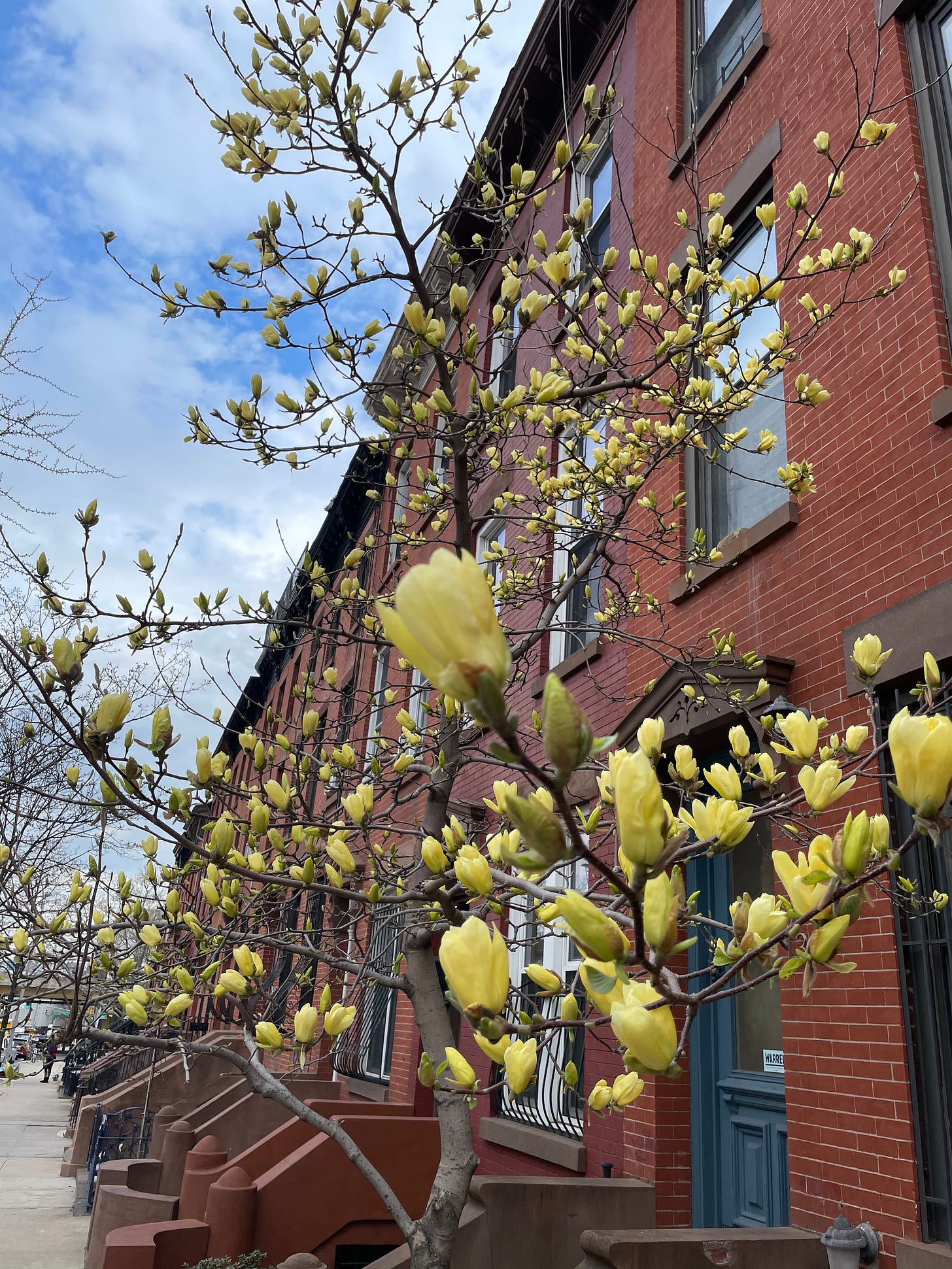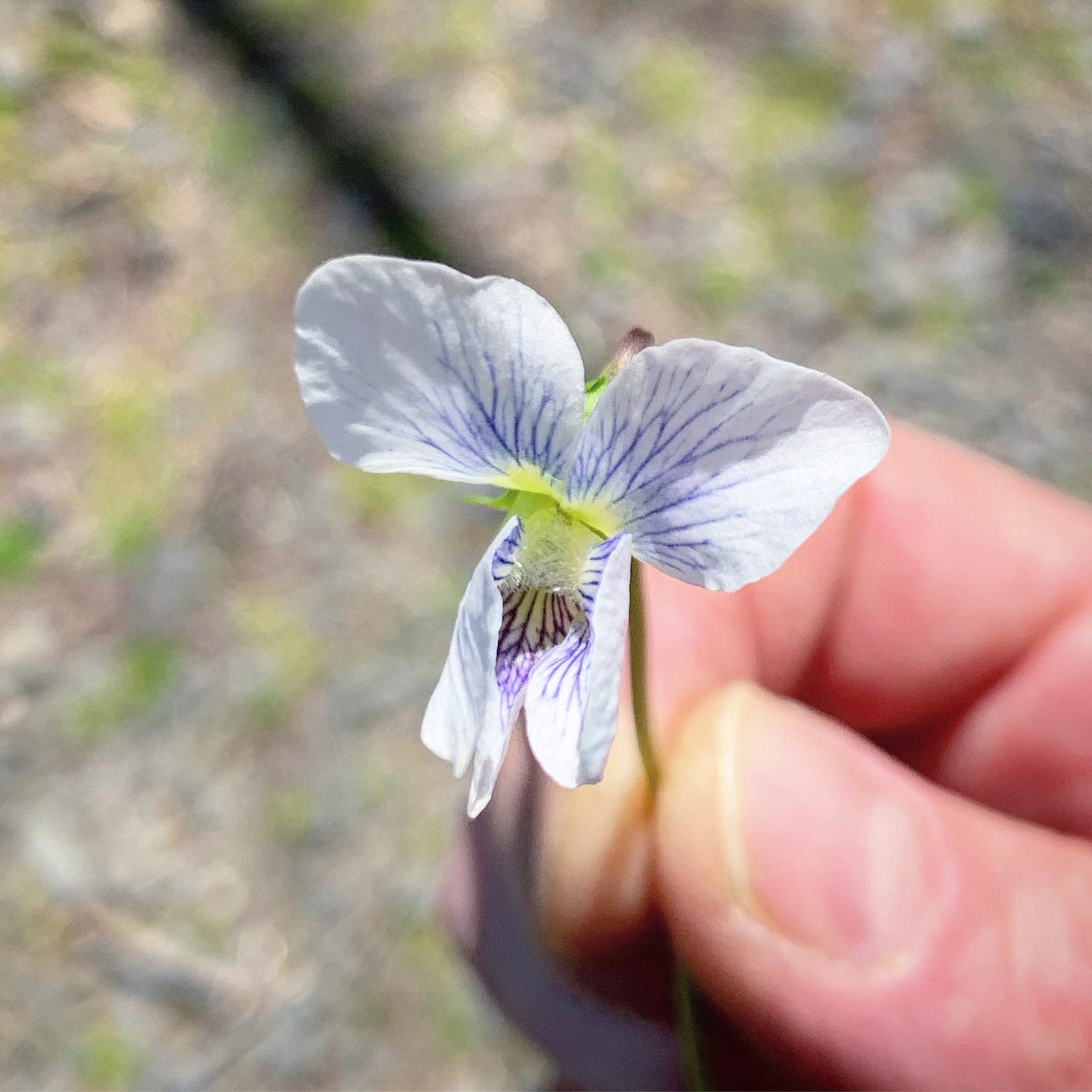Spring flowers have popped in NYC (+ adjacent climes), and I am overjoyed. I aspire to commune with the universal clock of blooming flowers, and the first ones of spring are always especially meaningful. First come the snowdrops, then the crocus, Siberian squill (those lil blue flowers turned down that smell like corn), Lenten rose, daffodil, magnolia, tulip, and many others. Not to mention the coming alive of tree flowers all over NYC – Callery pear, cherry blossom, eastern redbud, crab apple, etc. I literally cannot get over how incredible it is to witness a tree in full flower. It never gets old.
I sniff spring flowers every year and try to take vivid notes in the mind for use in perfumes. I make aromatic studies of them and keep for them for future use. I will use them abstractly as a note within larger narrative or make solo flower fumes about any one of them. I have made several Studio Juices for DSD that were based on single flowers growing in the wilds of NYC: LILAC CITY, MAGNOLIA CITY, SUCKLE HONEY CITY. Here’s some thoughts on those & some of my most cherished spring flowers.
Crocus
Each year, our family visits the Brooklyn Botanical Garden for the most epic field of purple crocus this side of the Hudson. Crocus is my favorite looking flower – little egg cups of vibrant color hiding a saffron stamen. I can’t help but feel as though Mama Nature loves to decorate the landscape for Easter/Passover/Holi/etc with them. Like many flowers with very little smell, I suggest trying to catch them at all times of day and to really get your nose in there. There is usually some aroma even if it’s just a vague green/floral. There are so many varieties of each flower, and some are bound to smell. The crocuses that have emitted anything to me, said a vague sweetness with a somewhat fresh dew aroma. If I were to construct crocus in a perfume, I would dilute saffron or saffron smelling aromachems (safraleine or safranal which is super strong and regulated - traces could start to give a base layer for building crocus). I imagine small amounts of powdery ethyl vanillin and musks with bits of green materials like hexyl tiglate would start painting the aroma inside the petals. One could also play with colors – purple, white, lavender, or yellows to further focus the crocus.
Daffodil
This is an actual ingredient we have in the perfumer’s palette. The name used in perfume is usually the French word “jonquil”. Jonquil or daffodil absolute, like the flower itself is quite a dusty affair. It is a polarizing flower fume. Daffodils have a spicy cinnamic throw under dirty, earthy animalic floralcy. They almost always conjure images of grandmas to me – knit cardigans, pearl necklaces, smiles, canes. It is powdery like perfumes from another era. I do not reach for this much, but in over-the-top florals, jonquil can be new and exciting when combined with jasmine, rose, dark ambers, & orris. It’s muy expensivo too.
Magnolia
Magnolia flowers really vary but they are among the most perfumy in our climate. What I mean, is the aroma of magnolia is so complex that it is like a perfume in and of itself. To me magnolia smells of citrus over soft skin cream, white or green tea, with a very balanced powdery floral aroma. Magnolia is a saucer of cream, with subtly spice & musk. Something that multifaceted needs little else to make a perfume. Magnolia Absolute does not capture the aroma of the real flower. Instead, the rich brown oil smells of damp leaves and humid petals. When building the aroma of magnolia, we need to add in lemons, musks, tea, and the creamier warm musks like Exaltenone, Helvetolide, Cosmone, or Velvione. Small amounts of vanilla are useful but not if you can smell “vanilla.” It must be a touch. Ionones can help fill in florally, and some amount of spice from eugenol (clove) materials is useful to make it all come to life. Our MAGNOLIA CITY was a study on a particular yellow magnolia that was invented by the Brooklyn Botanical Garden. There are a few growing in front of houses in Fort Greene by our Navy Yards office. I make a pilgrimage every year (Washington between Myrtle & the BQE if you wanna sniff).
Cherry Blossom
This is another one that most people will say has no aroma. However, if you catch them on the right day, you will notice cherry blossoms’ faint almond scent. If you make a syrup from the flowers, you will certainly notice its strong almond scent. I used a cherry blossom accord in a perfume I made for KITH called SUMMER IN QUEENS for the area founder Ronnie Feig grew up. I also experienced a glorious cherry blossom tree in Canterbury that gave me further thoughts on how to capture its aroma. It all begins with benzaldehyde, the old stalwart, used in flavoring and fragrances for cherry, almond, and pistachio. You can massage the benzaldehyde with silvery fresh materials like Para methyl phenylacetaldehyde or helional. I also like musky-floral-almond phenyl ethyl alcohol & phen ethyl isobutyrate. There are so many aromachems that you find traces of in tree flowers. Using them in perfume is a bit like water coloring in painting. The materials overlay and create blooms of billowing blossoms on the wind.
Lily-of-the-Valley
Nothing is more arresting than coming across a patch of lily-of-the-valley. The shape of the stem hanging little bells of light for dwellers of the forest floor is certainly a joyous thing. LOTV is so complex. It is green & rubbery and definitely smells a bit toxic (which it is). The floral aroma smells white, powdery and decidedly dainty. I have been working on a photorealistic version since at least 2014. My current version has 59 ingredients. To get it just right so far I need: bergamot, lemon, grassy salicylates, clove, aroma chems that are parts of tuberose, everlasting flower, hazelnut, jasmine, lime, orris, maltol, musks, hay, pear, mint, oakmoss, pink pepper, tomato stem, rose, violet, vetiver, green banana notes, and many materials in the muguet (French name of LOTV) family. Suffice to say if I ever get it right, it will be a complete house of cards. I can already hear the haters ripping on it!
Violet
I could & should do a whole post on violets - as the chemicals that make up violet aromas are among the most important heart notes in perfumery. That being said the violets that we have in NYC sprouting up in spring are not heavily scented. For reasons why please refer to April Long’s impeccably informative Substack on the subject. If you want to sniff violets here, you have to get on the ground on a sunny day and slip your schnoz deep in the flower. You will notice a faint whiff of ionones, but also an aroma of mothballs (indole). I discovered this fact in a white violet growing in Fort Greene Park. I soon made a realistic copy of this flower using violet leaves, ionones, moss, & indole. This accord went into a candle I made for a shop uptown called KRB.
Lilac
A late spring Goddess. If crocus is my fave looking, lilac is my fave smelling. Lilac seems so simple (an accord with phenyl ethyl alcohol, helional, indole, & clove is a starting point), but when you study it, many facets emerge. Lilac smells like the border of a fine English China plate. It is regal, provincial, & quite prim. It smells frosty, purple, or white, has a green hawthorn-like middle. Besides clove, anise notes are there too - anisaldehyde to be exact. I detect terpene alpha as well with its very bitter-wood-in-greenhouse note. LILAC CITY which we make exclusively for Bergdorf’s is in my personal top ten. I think a lilac perfume is a great way to smell them all year. Real ones are so fleeting and soon become odd-looking orbs hanging in the wind.
Happy Spring y’all. See you outside!
https://krbnyc.com/collections/krb-candle/products/krb-signature-candle













You have the gift of writing descriptions to appeal to all the senses. I enjoyed how you equated lilac to the rim of a china teacup. Incredibly poetic!
Reading this felt like being in the spring sunshine! Utterly beautiful.